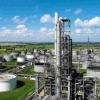Dear Sirs,
Good day.
Hope everyone is doing well.
Please excuse my ignorance but i would like to seek your opinion regarding backflushing of heat exchangers. Currently I am having a consistency check in our P&ID and I came across this subject.
I understand that backflushing is washing the silts and solid deposits in the tube side of heat exchanger by redirecting the cooling water to pass through the outlet nozzle of the tubeside and exit in the inlet nozzle and out in the "backwash valve" as shown in attached drawing.
I have come across three (3) configurations in our PID
--> there is a 3/4"-drain valve downstream of isolation valve in backflush line
--> there is a 3/4"-drain valve upstream of isolation valve in backflush line
--> there is no drain valve in backflush line
My queries are as follows,
1) how does this 3/4-drain valve works? is it to monitor if there's a flow?
2) there is a vent valve that has a note "top connection". Does this monitor if there's a flow during backflushing? (like overflowing?)
3) I have observe that in small piping like 3" and below, the PID shows a globe valve in the cooling water return line (does this means that during back flushing, cooling water return to header is gradually close and not instantaneously?)
4) There are three (3) exchangers having the third configuration, i.e. having no TI on the outlet piping (the PID is from a different licensor). I believe TI is necessary, please enlighten me.
Thank you so much for taking your time.
Sincerely,
gimenz

 FB
FB














